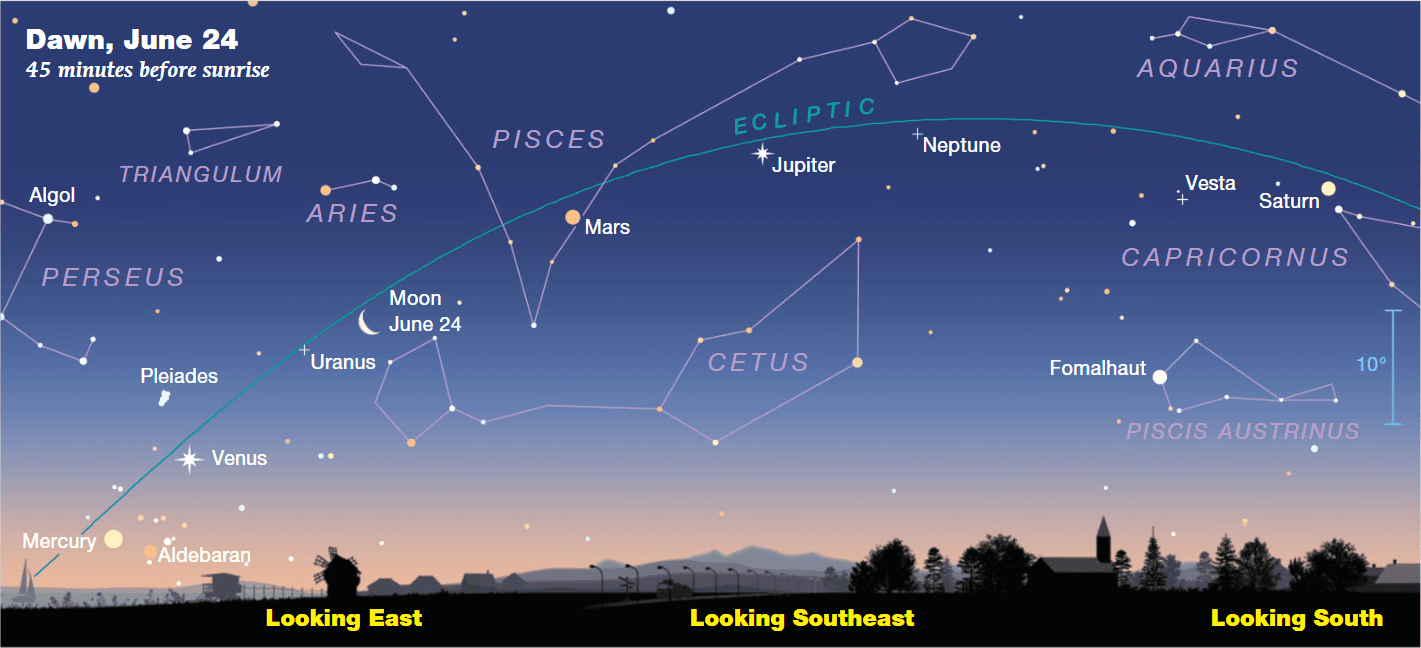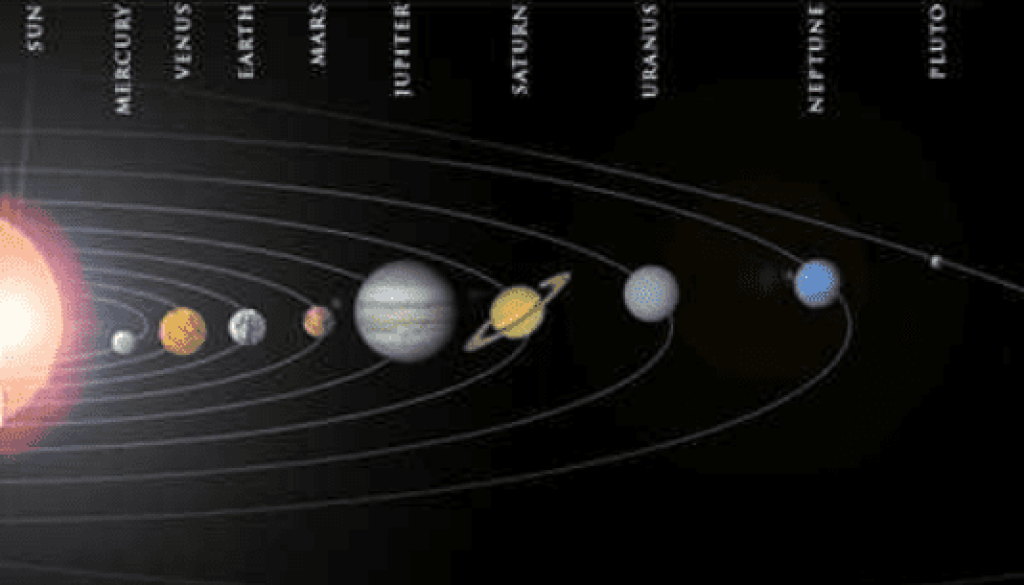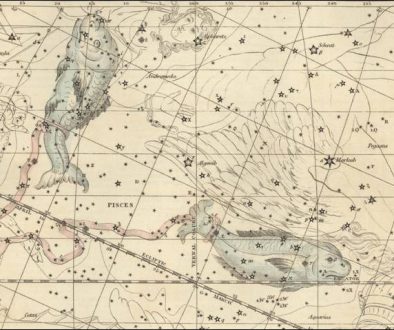A Rare Planetary Alignment
There will be an interesting alignment of the moon and seven of the nine planets orbiting the sun on June 24, 2022. Other than Earth, Pluto is the only other planet that is not in this lineup. Pluto is no longer considered a planet by most Astronomers because of its small size. Pluto is now classified as a planetoid. This type of alignment occurs about every twenty-five years. But with all seven planets involved, this event is rarer than normal. It would take me days to go through possibly thousands of years to find out how rare this particular alignment is, which I do not have the time to do at this time. Below is a chart of this event from the June issue of Sky & Telescope, pg. 48. The planets are continuously moving in their orbits around the sun and this alignment will be seen in its various stages through early July.
 Chart from top of page 48 in June issue of Sky & Telescope Magazine
Chart from top of page 48 in June issue of Sky & Telescope MagazineMy Thoughts on Planet X
I am no fan of all the Planet X theories out there and spent twenty years putting them all down. After being away from it all for nine years, I should have realized that after I started writing again, that this would pop up again. When I got the phone call last month from Tim Foster, he described how the events he was talking about went along with what I had written about in my last blog on the close conjunction of Jupiter and Mars in the Sign Pisces. I listened to the first part of each video of the videos he sent me. It was all I had time for at the time, before posting them. There wasn’t much on his thoughts about Planet X until further into the videos, which I listened to much later. In our discussion, I thought at first that he was speaking of Planet X which was recently discovered by NASA as a possible rogue planet on the other side of Uranus. See the July 2022 issue of Sky & Telescope article “The Elusive Planet X“. The digital version of that issue was delivered to my Kindle two or three days before Tim called me on May 27. I later discovered that Tim was speaking of the neutron star theory Planet X, of which there is no physical proof of yet.
I do not agree with Tim Foster’s theory about Planet X being a neutron star. The gravitational field of a neutron star is immense. If a neutron star were to pass by the earth at the same distance as the moon, it would rip us out of our orbit around the sun. Tim shows photos where he says planet X is visible. If it were that close to be visible, it would be devastating to our planet. Nothing living would be left. So, if this were true, it really doesn’t matter what we think.
A neutron star has the mass about 1.4 times the mass of our sun, but is not much bigger than a small city, about 10 miles in radius. Just a teaspoon of neutron star dust weighs about 10 million tons. (Think about how many teaspoons you can put into a globe that has a twenty-mile diameter). Its gravitational field is immense. It’s escape velocity is about O.4 times the speed of light, or about 27,000,000 miles per hour. The escape velocity from Earth for the space shuttle is around 17,400 miles per hour. If a neutron star were to pass close by the earth, the effects would be devastating, how much so would depend on how close it passed by.
I still thank Tim for sharing all of his hard work with us. The subscribers can discuss this and make an informed decision on it for themselves. I do thank Tim for the other information he shared with us.
The Earth Will Topple on its Axis???
Some believe that the upcoming planetary on May 29 will topple the earth on its axis or cause huge earthquakes and massive floods worldwide. That is far from the truth. People were saying the same thing about the planetary alignment of May 5th, 2000. Below is an article that I wrote about the subject in the June 1997 Biblical Astronomy newsletter titled Celestial Alignment of May 5, 2000, which was still three years in the future at that time. I show that by the laws of physics that YeHoVaH set up when He created the heavens and the earth, that for this planetary alignment to have such an effect on Earth would not be possible.
Although this planetary alignment has two more planets added to the alignment, Uranus and Neptune, their distance from the earth is so great that their extra gravitational pull on the earth is very miniscule. Even if all eight of the other planets and the moon were lined up in a straight line on one side of Earth, the extra gravitational pull compared to the gravitational pull of the sun would be very miniscule. And of course, there could only be six of the planets on one side of the earth since Venus and Mercury are inner planets. It is the distance of the planets Jupiter, Saturn, Uranus, Neptune and Pluto which all are many hundreds of millions to billions of miles away instead of tens of millions of miles for the inner planets of much less mass that play a huge factor on their gravitational affect on Earth.
CELESTIAL ALIGNMENT OF MAY 5, 2000
Throughout the last year, I have received many questions concerning the planetary alignment that is to occur on May 5, 2000. Supposedly, the Moon, Sun, Mercury, Venus, Mars, Jupiter, and Saturn are to be in direct alignment (in a straight line), which is not the case. Chart 36 shows the alignment on May 24 at 2:28 a.m. Israel Standard Time. I chose this particular time as the moon, sun, and earth are in direct alignment. This is about as close as all bodies considered come to being in direct alignment. The planets are moving in a clockwise direction around the sun, and the moon is moving in a counterclockwise direction around the earth from this vantage point. I drew a line from the earth through the sun to the orbital path of Saturn to show how close or far off the actual alignment of the planets is. The line extending from the orbital path of Mercury is the 0-degree longitude line. Some have written or suggested that such an alignment will8m cause the earth to topple on its axis, or that the gravitational force caused by the alignment will cause great earthquakes. This is HIGHLY unlikely. The laws of physics do not allow this. I did the calculations to provide scientific proof using Newton’s law of gravitation. The equation is: F=G(M1M2/r2). F is the gravitational force in Newtons (1 newton is equal to the force needed to accelerate 1 kilogram by 1 meter per second); G is the gravitational constant which equals 6.672 x 10-11M3/Kg.sec2 (cubic meters divided by kilograms per second), M1 is the mass (in kilograms) of first object (ex. Earth), M2 is the mass of the second object (ex. Moon), and r is the distance (in meters) between the two objects (r2 being the square of the distance: if the distance between the two objects is 10 meters, then you would divide the multiple factor of the two masses by 100). I did all of the calculations for the sun, moon, and all of the planets under consideration for this particular day and time. The gravitational force that the sun will exert on Earth on May 4/5, 2000 will be approximately 3.48 x 1022 Newtons. The gravitational force that the moon will exert on Earth will be approximately 2.13 x 1020 Newtons. The total gravitational force that all of the five planets (Jupiter, Saturn, Mars, Venus, and Mercury) combined will exert on Earth will be 1.06 x 1018 Newtons. The x 10x are powers of ten (ex. 1.2 x 106 = 1.2 million, 1.2 x 109 = 1.2 billion, 1.2 x 1012 = 1.2 trillion). The total gravitational force of the sun and moon on Earth at this particular time is over 33,000 times greater than the combined force of all five planets. The earth is constantly subject to forces of this magnitude. There is far from enough excessive gravitational force to send the earth toppling on its axis, even if the planets were in direct alignment. To say that this minuscule difference in gravitational force would topple the earth is analogous to saying that a small fly striking the helmet of Bruce Smith of the Buffalo Bills as he is rushing in for a tackle would knock him on his butt. HIGHLY unlikely.
On another note, Astronomers have now theorized, because of abnormal gravitational perturbations around Neptune, that there is a large planet that orbits Neptune. Because of its orbital elements, it stays hidden from us. They call this planet, Planet X, because it would be the tenth planet discovered in our solar system, the Roman numeral X being equivalent to the Arabic number 10. See the article “The Elusive Planet X” in the July 2022 issue of Sky & Telescope.




June 15, 2022 @ 5:27 pm
Very interesting article. Thank you for sharing.
June 15, 2022 @ 8:17 pm
Please note that “Planet X” has already been discussed since 1990 by a former naval observatory chief. I’m not sure what it is but something will cause Isaiah 24 to come to pass at some point.
https://youtu.be/2lrlbmg_J50
June 15, 2022 @ 10:41 pm
4 Corners.
June 16, 2022 @ 3:31 am
The following is an excerpt from the article “The Elusive Planet X” In the July 2022 issue of Sky & Telescope concerning updates in the search for Planet X.
“Some astronomers suspect that a ninth planet lurks in the most distant reaches of the solar system. Does it really exist?
Of everything we know about our solar system, the number of planets orbiting the Sun might seem like one thing that we should have nailed down. And yet, there have been rumors of another world, lurking beyond Neptune. This is no dwarf planet like Ceres or Pluto, but a world with some heft, possibly five to 10 times as massive as Earth. The primary hints of its existence comes from a paltry number of diminutive icy objects whose orbits all appear to be bunched up in one quadrant of the solar system (S&T Oct. 2017, p.16).
For the past six or so years, Konstantin Batygin (Caltech) has been at the forefront of the hunt for this elusive world, tuned as planet X, by others as Planet Nine (sorry Pluto).
‘Here’s the update,’ he says. ‘We haven’ t found it yet.’
That’s not for lack of trying. Planet sleuths have been hunting in various ways – searching through old telescope images for a possible glimpse of this phantom planet; looking for more of those tiny objects, to see if they’re bunched up as well; poring over data on the small bodies we do know about, to see what other secrets they hold; and running computer simulations to better understand how an extra planet might interfere with the motions of things that orbit far from the sun.
Despite all that effort, we’re no closer to the clear answer. Some say it’s a slam dunk. Everyone says we need more data with a lot of hope pinned on the upcoming Vera C, Rubin Observatory which could settle the debate once and for all.
‘It is the way science works,’ says Scott Shepard (Carnegie Institute of Science), one half of the duo who first proposed that this planet might exist. ‘At some point, the data reach a a tipping point where the hypothesis is either ruled out or it becomes much, much stronger. And we just haven’t reached that yet.’
Hypothesis Testing
Astronomers have been planning the existence of additional planets for more than 170 years. Irregularities in the orbit of Uranus led to the discovery of Neptune in 1846. Further apparent orbital oddities in those planets and in some comets sparked many suggestions of additional planets throughout the late 19th and early 20th centuries. One of those proposals triggered the search that, by chance, found Pluto………”
June 16, 2022 @ 2:59 pm
Thanks Bob. I will put that on the calendar. That also happens to be my daughter’s 43rd birthday.
June 16, 2022 @ 5:48 pm
Hi Bob. Thanks for drawing our attention to another amazing massing of the planets. What I find interesting is the progressive alignment of each naked eye planet and a waning Moon starting with Saturn in the evening sky on June 18, then moving to the morning sky on June 22 etc. over a few nights.
June 18: Saturn and the Moon
June 22: Jupiter and the Moon
June 23: Mars and the Moon
June 26: Venus and a crescent Moon
June 27: Mercury and the Moon
Any insights/interpretation as to this Voice in the Heaven that is speaking to us would be appreciated?
July 16, 2022 @ 1:52 pm
Mr. Wadsworth, Thank you for a fantastic article. I follow you and the Mazzaroth Maniacs. I know the sun and the moon when I see it, but I am so new I can not tell the biblical constellations and their signs. Is there a course and or books on learning the Mazzaroth of the scriptures? The story from our Father is in the heavens and I want to learn it. I’d appreciate any help you can share with me.
Shalom